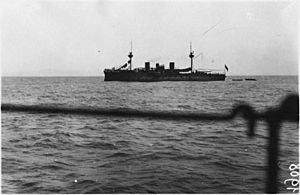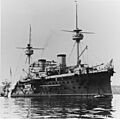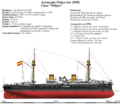Spanish battleship Pelayo facts for kids
class="infobox " style="float: right; clear: right; width: 315px; border-spacing: 2px; text-align: left; font-size: 90%;"
| colspan="2" style="text-align: center; font-size: 90%; line-height: 1.5em;" | 
|} The Pelayo was a powerful battleship that served in the Spanish Navy from 1888 to 1925. It was the first battleship ever built for Spain. At the time, it was the strongest ship in the Spanish fleet.
Even though Pelayo was a modern ship, it never fought in the Spanish–American War. Some people believe that if Pelayo and another strong ship, the armored cruiser Carlos V, had joined the fight, Spain might have won the war. This could have helped Spain keep its status as a colonial power.
Contents
| History | |
|---|---|
| Name | Pelayo |
| Namesake | Pelagius of Asturias |
| Builder | Forges et Chantiers de la Méditerranée La Seyne, France |
| Laid down | April 1885 |
| Launched | 5 February 1887 |
| Completed | summer 1888 |
| Nickname(s) | Solitario ("Solitary" or "Lonely") |
| Fate | Disarmed 1923; scrapped 1925 |
| General characteristics | |
| Type | Battleship |
| Displacement |
|
| Length | 393 ft 8 in (119.99 m) |
| Beam | 66 ft 3 in (20.19 m) |
| Draft | 24 ft 9 in (7.54 m) maximum |
| Installed power | 9,600 ihp (8,000 ihp on trials with natural draft) |
| Propulsion | 2-shaft, vertical compound, 12 return-tube boilers; in 1897–1898 her boilers were replaced by 16 Niclausse boilers. |
| Sail plan | As built 4,000 square feet (1,219 square meters), but quickly removed. |
| Speed |
|
| Complement | 520 officers and enlisted |
| Armament |
|
| Armor |
|
| Notes | 800 tons of coal |
Building the Pelayo: A Look at its Design
The Pelayo was ordered in November 1884. It was built by a French company called Forges et Chantiers de la Méditerranée in La Seyne, France. Construction started in April 1885. The ship was launched into the water on February 5, 1887, and finished in the summer of 1888.
The Spanish Navy first planned to build more ships like Pelayo. However, a disagreement with the German Empire over the Caroline Islands in 1890 changed these plans. The money was instead used to build other ships, like the Infanta Maria Teresa-class armored cruisers. Pelayo was considered too slow and couldn't carry enough coal for long trips to colonies. Because of this, Pelayo ended up being the only ship of its kind.
How Was Pelayo Designed?
The design of Pelayo was based on a French battleship called Marceau. However, Pelayo was built to sit about 3 feet (0.91 m) shallower in the water. This was so it could easily pass through the Suez Canal when fully loaded.
When first built, Pelayo had sails, but these were removed soon after. It had two funnels. Its 16-centimetre (6.30 in) gun was placed at the front to fire straight ahead. The ship's armor belt was 6 feet 11 inches (2.11 m) wide in the middle. This armor went 2 feet (0.61 m) above and almost 5 feet (1.5 m) below the waterline. Inside, the ship had a special design with 13 waterproof sections and a double bottom, which made it very strong.
Pelayo was a "barbette ship." This means its main guns were placed on open, armored platforms that could spin. This was different from the heavy, enclosed gun turrets that became common later on battleships.
The main guns on Pelayo could be loaded from any position. It had two large 32-centimetre (12.6 in) guns, one at the front and one at the back. It also had two 28-centimetre (11.0 in) guns, one on each side. All these guns were made by Gonzalez Hontoria.
What Changes Were Made to Pelayo?
Pelayo was updated in France between 1897 and 1898. During this time, its middle gun area got more armor. Its smaller 16-and-12-centimetre (6.30 and 4.72 in) guns were replaced with newer 14-centimetre (5.51 in) guns. One of these new guns was placed at the front, and the others were on the sides. However, the work was rushed when the Spanish–American War started, so the new guns were not fully installed right away.
In 1910, Pelayo had another big update. All of its torpedo tubes were removed during this time.
Pelayo's Journey: A History of Service
In its early years, Pelayo stayed mostly in Spanish waters. It often traveled to different places to represent Spain's navy. It visited Greece in 1891, Genoa, Italy, in 1892, and Kiel, Germany, in 1895. These trips were like showing off the flag.
The Spanish-American War and Pelayo
Pelayo was being updated in France when the Spanish–American War began in April 1898. It was quickly put back into service. Its old guns had been removed, but the new ones were not yet fully installed. On May 14, 1898, it joined the Reserve Squadron.
For about a month, Pelayo stayed near Spain to protect the coast from attacks by the United States Navy. Then, it was sent to join the 2nd Squadron. This squadron, led by Rear Admiral Manuel de Cámara, was supposed to sail to the Philippines. Their mission was to defeat the U.S. Navy's Asiatic Squadron, which had taken control of Philippine waters.
Cámara's squadron left Cadiz on June 16, 1898. It included Pelayo, the armored cruiser Emperador Carlos V, and several other ships. They reached Port Said, Egypt, on June 26, 1898. They asked to get coal there, but Egypt refused on June 30, saying it needed to stay neutral.
By the time Cámara's squadron reached Suez on July 5, 1898, another Spanish squadron had been destroyed in the Battle of Santiago de Cuba. This meant the U.S. Navy's main forces were now free. Fearing for Spain's coast, the Spanish government called Cámara's squadron back on July 7, 1898. Pelayo returned to Spain, and the squadron was broken up on July 25, 1898. Because of this, Pelayo did not see any combat during the war.
Later Years and Retirement
After the war, Pelayo continued its role of representing Spain. It attended naval events in Toulon, France, in 1901, and in Lisbon, Portugal, and Vigo Bay, Spain, in 1904. However, the Spanish Navy found it hard to find a good role for Pelayo. There were no other ships like it to work with.
There was an idea to have Pelayo work with Spain's new, modern battleships, the España-class, which came into service around World War I. But by then, Pelayo was too old and slow to keep up with them. This is why it earned the nickname Solitario, which means "The Lonely One."
Pelayo only fired its guns in a real battle once. This happened in 1909 when it bombed Moroccan rebels during the Second Rif War.
In 1912, Pelayo was badly damaged in Fonduko Bay due to a navigation mistake. It was repaired, but after that, it mostly served as a training ship. In 1920 and 1921, it was used to train sailors in gunnery. Pelayo was taken out of service in 1923 and was scrapped, or taken apart, in 1925.
Images for kids
See also
 In Spanish: Pelayo (1888) para niños
In Spanish: Pelayo (1888) para niños










